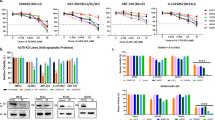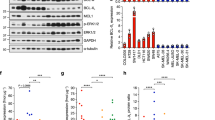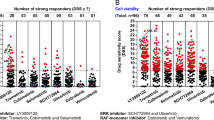Abstract
Melanoma cells driven by mutant v-raf murine sarcoma viral oncogene homolog B1 (B-RAF) are highly resistant to chemotherapeutic treatments. Recent phase 1 results with PLX4032/RG7204/vemurafenib, which selectively inhibits B-RAF/mitogen-activated protein kinase kinase (MEK)/extracellular signal-regulated kinase (ERK)1/2 signaling in mutant B-RAF cells, has given encouragement to this struggling field. Nearly all patients in the phase 1–3 studies saw at least some response and the overall response rates ranged from 48 and 81%. However, despite initial tumor shrinkage, most responders in the trial experienced tumor relapse over time. These findings indicate that both intrinsic and acquired resistance may affect the clinical efficacy of PLX4032. It is critical to optimize PLX4032 activity to improve response rates and understand why some patients with the B-RAF mutation do not respond. We have previously shown that the stemness factor, Forkhead box D3 (FOXD3), is upregulated following inhibition of B-RAF–MEK signaling in mutant B-RAF melanoma cells. Here, we show that upregulation of FOXD3 following treatment with PLX4032 and PLX4720 (the non-clinical tool compound for PLX4032) confers resistance to cell death. Small interfering RNA-mediated knockdown of FOXD3 significantly enhanced the cell death response after PLX4032/4720 treatment in mutant B-RAF melanoma cell lines. Additionally, upregulation of FOXD3 after PLX4720 treatment was attenuated in non-adherent conditions and correlated with enhanced cell death. Ectopic expression of FOXD3 in non-adherent cells significantly reduced cell death in response to PLX4720 treatment. Together, these data indicate that upregulation of FOXD3 is an adaptive response to RAF inhibitors that promotes a state of drug resistance.
This is a preview of subscription content, access via your institution
Access options
Subscribe to this journal
Receive 50 print issues and online access
$259.00 per year
only $5.18 per issue
Buy this article
- Purchase on Springer Link
- Instant access to full article PDF
Prices may be subject to local taxes which are calculated during checkout






Similar content being viewed by others

References
Abel EV, Aplin AE . (2010). FOXD3 is a mutant B-RAF-regulated inhibitor of G1/S progression in melanoma cells. Cancer Res 70: 2891–2900.
Aplin AE, Kaplan FM, Shao Y . (2011). Mechanisms of resistance to RAF inhibitors in melanoma. J Invest Dermatol 131: 1817–1820.
Boisvert-Adamo K, Aplin AE . (2006). B-RAF and PI-3 kinase signaling protect melanoma cells from anoikis. Oncogene 25: 4848–4856.
Bollag G, Hirth P, Tsai J, Zhang J, Ibrahim PN, Cho H et al. (2010). Clinical efficacy of a RAF inhibitor needs broad target blockade in BRAF-mutant melanoma. Nature 467: 596–599.
Chapman PB, Hauschild A, Robert C, Haanen JB, Ascierto P, Larkin J et al. (2011). Improved survival with vemurafenib in melanoma with BRAF V600E mutation. N Engl J Med 364: 2507–2516.
Davies H, Bignell GR, Cox C, Stephens P, Edkins S, Clegg S et al. (2002). Mutations of the BRAF gene in human cancer. Nature 417: 949–954.
Dean M, Fojo T, Bates S . (2005). Tumour stem cells and drug resistance. Nature Rev Cancer 5: 275–284.
Dhomen N, Marais R . (2007). New insight into BRAF mutations in cancer. Curr Opin Genet Dev 17: 31–39.
Flaherty KT, Puzanov I, Kim KB, Ribas A, McArthur GA, Sosman JA et al. (2010). Inhibition of mutated, activated BRAF in metastatic melanoma. N Engl J Med 363: 809–819.
Hanna LA, Foreman RK, Tarasenko IA, Kessler DS, Labosky PA . (2002). Requirement for Foxd3 in maintaining pluripotent cells of the early mouse embryo. Genes Dev 16: 2650–2661.
Hendrix MJC, Seftor EA, Seftor REB, Kasemeier-Kulesa J, Kulesa PM, Postovit L-M . (2007). Reprogramming metastatic tumour cells with embryonic microenvironments. Nat Rev Cancer 7: 246–255.
Hoeflich KP, Herter S, Tien J, Wong L, Berry L, Chan J et al. (2009). Antitumor efficacy of the novel RAF inhibitor GDC-0879 is predicted by BRAFV600E mutational status and sustained extracellular signal-regulated kinase/mitogen-activated protein kinase pathway suppression. Cancer Res 69: 3042–3051.
Johannessen CM, Boehm JS, Kim SY, Thomas SR, Wardwell L, Johnson LA et al. (2010). COT drives resistance to RAF inhibition through MAP kinase pathway reactivation. Nature 468: 968–972.
Joseph EW, Pratilas CA, Poulikakos PI, Tadi M, Wang W, Taylor BS et al. (2010). The RAF inhibitor PLX4032 inhibits ERK signaling and tumor cell proliferation in a V600E BRAF-selective manner. Proc Natl Acad Sci USA 107: 14903–14908.
Li X, Lewis MT, Huang J, Gutierrez C, Osborne CK, Wu M-F et al. (2008). Intrinsic resistance of tumorigenic breast cancer cells to chemotherapy. J Natl Cancer Inst 100: 672–679.
Liber D, Domaschenz R, Holmqvist P-H, Mazzarella L, Georgiou A, Leleu M et al. (2010). Epigenetic priming of a pre-B cell-specific enhancer through binding of Sox2 and Foxd3 at the ESC stage. Cell Stem Cell 7: 114–126.
Liu Y, Labosky PA . (2008). Regulation of embryonic stem cell self-renewal and pluripotency by Foxd3. Stem Cells 26: 2475–2484.
Michaloglou C, Vredeveld LC, Soengas MS, Denoyelle C, Kuilman T, van der Horst CM et al. (2005). BRAFE600-associated senescence-like cell cycle arrest of human naevi. Nature 436: 720–724.
Mundell NA, Labosky PA . (2011). Neural crest stem cell multipotency requires Foxd3 to maintain neural potential and repress mesenchymal fates. Development 138: 641–652.
Nazarian R, Shi H, Wang Q, Kong X, Koya RC, Lee H et al. (2010). Melanomas acquire resistance to B-RAF(V600E) inhibition by RTK or N-RAS upregulation. Nature 468: 973–977.
Pan G, Li J, Zhou Y, Zheng H, Pei D . (2006). A negative feedback loop of transcription factors that controls stem cell pluripotency and self-renewal. FASEB J 20: 1730–1732.
Pollock PM, Harper UL, Hansen KS, Yudt LM, Stark M, Robbins CM et al. (2003). High frequency of BRAF mutations in nevi. Nat Genet 33: 19–20.
Ribas A, Kim K, LM S, Gonzalez R, Pavlick A, Weber J et al. (2011). BRIM-2: an open-label, multicenter phase II study of vemurafenib in previously treated patients with BRAFV600E mutation-positive melanoma. J Clin Oncol 29(Suppl): 8509.
Shao Y, Aplin A . (2010). Akt3-mediated resistance to apoptosis in B-RAF targeted melanoma cells. Cancer Res 70: 6670–6681.
Sharma S, Lee D, Li B, Quinlan M, Takahashi F, Maheswaran S et al. (2010). A chromatin-mediated reversible drug-tolerant state in cancer cell subpopulations. Cell 141: 69–80.
Smalley KSM, Sondak VK . (2010). Melanoma—an unlikely poster child for personalized cancer therapy. N Engl J Med 363: 876–878.
Sutton J, Costa R, Klug M, Field L, Xu D, Largaespada DA et al. (1996). Genesis, a winged helix transcriptional repressor with expression restricted to embryonic stem cells. J Biol Chem 271: 23126–23133.
Teng L, Mundell NA, Frist AY, Wang Q, Labosky PA . (2008). Requirement for Foxd3 in the maintenance of neural crest progenitors. Development 135: 1615–1624.
Thomas AJ, Erickson CA . (2008). The making of a melanocyte: the specification of melanoblasts from the neural crest. Pigment Cell Melanoma Res 21: 598–610.
Tsai J, Lee JT, Wang W, Zhang J, Cho H, Mamo S et al. (2008). Discovery of a selective inhibitor of oncogenic B-Raf kinase with potent antimelanoma activity. Proc Natl Acad Sci USA 105: 3041–3046.
Villanueva J, Vultur A, Lee JT, Somasundaram R, Fukunaga-Kalabis M, Cipolla AK et al. (2010). Acquired resistance to BRAF inhibitors mediated by a RAF kinase switch in melanoma can be overcome by cotargeting MEK and IGF-1R/PI3K. Cancer Cell 18: 683–695.
Wagle N, Emery C, Berger MF, Davis MJ, Sawyer A, Pochanard P et al. (2011). Dissecting therapeutic resistance to RAF inhibition in melanoma by tumor genomic profiling. J Clin Oncol 29: 3085–3096.
Wang YF, Jiang CC, Kiejda KA, Gillespie S, Zhang XD, Hersey P . (2007). Apoptosis induction in human melanoma cells by inhibition of MEK is caspase-independent and mediated by the Bcl-2 family members PUMA, Bim, and Mcl-1. Clin Cancer Res 13: 4934–4942.
Acknowledgements
We thank Dr Gideon Bollag (Plexxikon, Berkeley, CA, USA) for providing PLX4720, Dr Meenhard Herlyn (Wistar Institute, Philadelphia, PA, USA) for WM melanoma cell lines, and Dr Fred Kaplan for critical comments on this paper. This work was supported by National Institutes of Health (GM067893, CA125103), American Cancer Society (RSG-08-03-01-CSM) and a Joanna M Nicolay Melanoma Foundation scholarship. The Kimmel Cancer Center is supported by National Cancer Institute Support Grant 1P30CA56036.
Author information
Authors and Affiliations
Corresponding author
Ethics declarations
Competing interests
The authors declare no conflict of interest.
Additional information
Supplementary Information accompanies the paper on the Oncogene website
Supplementary information
Rights and permissions
About this article
Cite this article
Basile, K., Abel, E. & Aplin, A. Adaptive upregulation of FOXD3 and resistance to PLX4032/4720-induced cell death in mutant B-RAF melanoma cells. Oncogene 31, 2471–2479 (2012). https://doi.org/10.1038/onc.2011.424
Received:
Revised:
Accepted:
Published:
Issue Date:
DOI: https://doi.org/10.1038/onc.2011.424
Keywords
This article is cited by
-
Targeting BRD/BET proteins inhibits adaptive kinome upregulation and enhances the effects of BRAF/MEK inhibitors in melanoma
British Journal of Cancer (2020)
-
ERK-mediated phosphorylation regulates SOX10 sumoylation and targets expression in mutant BRAF melanoma
Nature Communications (2018)
-
Tanapoxvirus lacking a neuregulin-like gene regresses human melanoma tumors in nude mice
Virus Genes (2017)
-
JUN dependency in distinct early and late BRAF inhibition adaptation states of melanoma
Cell Discovery (2016)
-
Adolescent and young adult patients with cancer: a milieu of unique features
Nature Reviews Clinical Oncology (2015)


